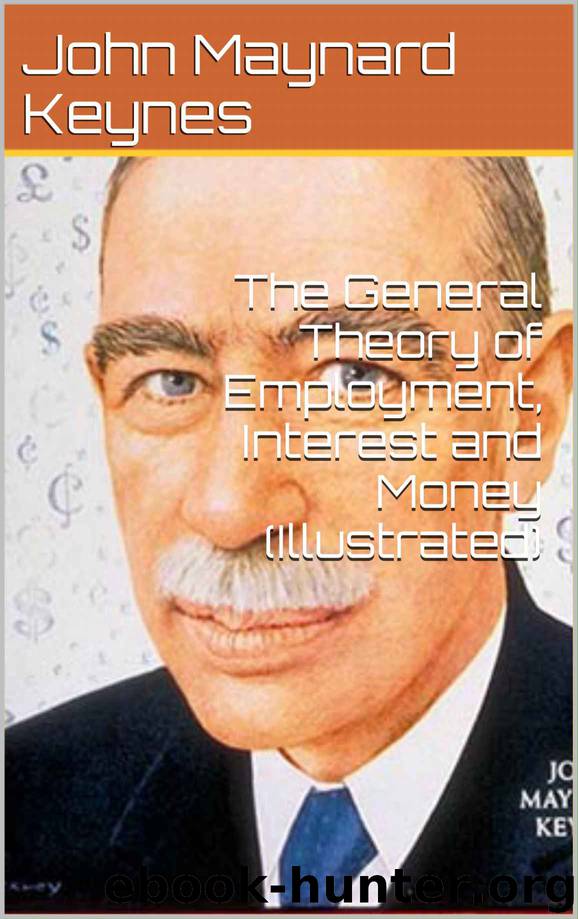The General Theory of Employment, Interest and Money (Illustrated) by John Maynard Keynes

Author:John Maynard Keynes
Language: eng
Format: mobi
Publisher: Green World Publication
Published: 2015-11-13T14:00:00+00:00
II
Whilst the amount of cash which an individual decides to hold to satisfy the transactions- motive and the precautionary-motive is not entirely independent of what he is holding to satisfy the speculative-motive, it is a safe first approximation to regard the amounts of these two sets of cash-holdings as being largely independent of one another. Let us, therefore, for the purposes of our further analysis, break up our problem in this way. Let the amount of cash held to satisfy the transactions- and precautionary-motives be M1, and the amount held to satisfy the speculative-motive be M2. Corresponding to these two compartments of cash, we then have two liquidity functions L1 and L2. L1 mainly depends on the level of income, whilst L2 mainly depends on the relation between the current rate of interest and the state of expectation. Thus
M = M1 + M2 = L1( Y) + L2(r),
where L1 is the liquidity function corresponding to an income Y, which determines M1, and L2 is the liquidity function of the rate of interest r, which determines M2. It follows that there are three matters to investigate: (i) the relation of changes in M to Y and r, (ii) what determines the shape of L1, (iii) what determines the shape of L2.
(i) The relation of changes in M to Y and r depends, in the first instance, on the way in which changes in M come about. Suppose that M consists of gold coins and that changes in M can only result from increased returns to the activities of gold-miners who belong to the economic system under examination. In this case changes in M are, in the first instance, directly associated with changes in Y, since the new gold accrues as someone's income. Exactly the same conditions hold if changes in M are due to the government printing money wherewith to meet its current expenditure;—in this case also the new money accrues as someone's income. The new level of income, however, will not continue sufficiently high for the requirements of M1 to absorb the whole of the increase in M; and some portion of the money will seek an outlet in buying securities or other assets until r has fallen so as to bring about an increase in the magnitude of M2 and at the same time to stimulate a rise in Y to such an extent that the new money is absorbed either in M2 or in the M1 which corresponds to the rise in Y caused by the fall in r. Thus at one remove this case comes to the same thing as the alternative case, where the new money can only be issued in the first instance by a relaxation of the conditions of credit by the banking system, so as to induce someone to sell the banks a debt or a bond in exchange for the new cash.
It will, therefore, be safe for us to take the latter case as typical. A change in M can be assumed
Download
This site does not store any files on its server. We only index and link to content provided by other sites. Please contact the content providers to delete copyright contents if any and email us, we'll remove relevant links or contents immediately.
International Integration of the Brazilian Economy by Elias C. Grivoyannis(75619)
The Radium Girls by Kate Moore(11634)
Turbulence by E. J. Noyes(7717)
Nudge - Improving Decisions about Health, Wealth, and Happiness by Thaler Sunstein(7261)
The Black Swan by Nassim Nicholas Taleb(6782)
Rich Dad Poor Dad by Robert T. Kiyosaki(6191)
Pioneering Portfolio Management by David F. Swensen(6089)
Man-made Catastrophes and Risk Information Concealment by Dmitry Chernov & Didier Sornette(5670)
Zero to One by Peter Thiel(5503)
Secrecy World by Jake Bernstein(4402)
Millionaire: The Philanderer, Gambler, and Duelist Who Invented Modern Finance by Janet Gleeson(4113)
The Age of Surveillance Capitalism by Shoshana Zuboff(3999)
Skin in the Game by Nassim Nicholas Taleb(3978)
The Money Culture by Michael Lewis(3857)
Bullshit Jobs by David Graeber(3843)
Skin in the Game: Hidden Asymmetries in Daily Life by Nassim Nicholas Taleb(3736)
The Dhandho Investor by Mohnish Pabrai(3572)
The Wisdom of Finance by Mihir Desai(3538)
Blockchain Basics by Daniel Drescher(3339)
